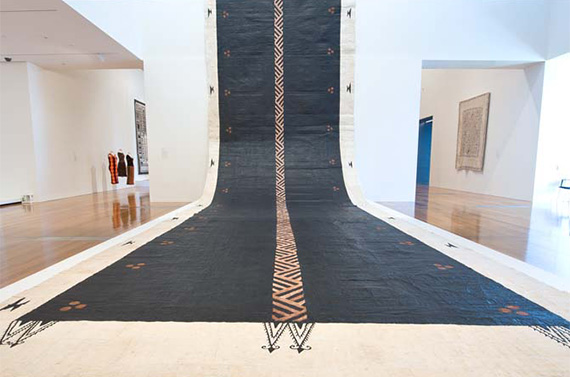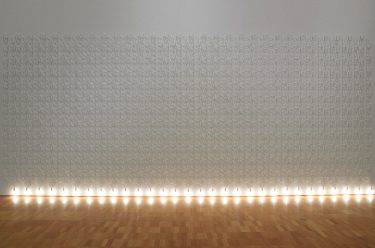
Seemingly fragile and ephemeral, the fibre works in ‘Lucent: Contemporary Aboriginal and Pacific textiles from the Collection’ represent the strength, vitality and resilience of Aboriginal and Pacific societies.
The Gallery is committed to acquiring contemporary textiles by Papua New Guinean, Asian, Pacific, Torres Strait Islander and Aboriginal Australian artists. ‘Lucent’ combines Aboriginal and Pacific fibre works from the Collection to focus on the diversity and strength of these artists’ distinctive aesthetic expressions. The exhibition highlights the continuing significance of traditional textiles, as well as the contemporary, within these two cultural and geographical contexts.
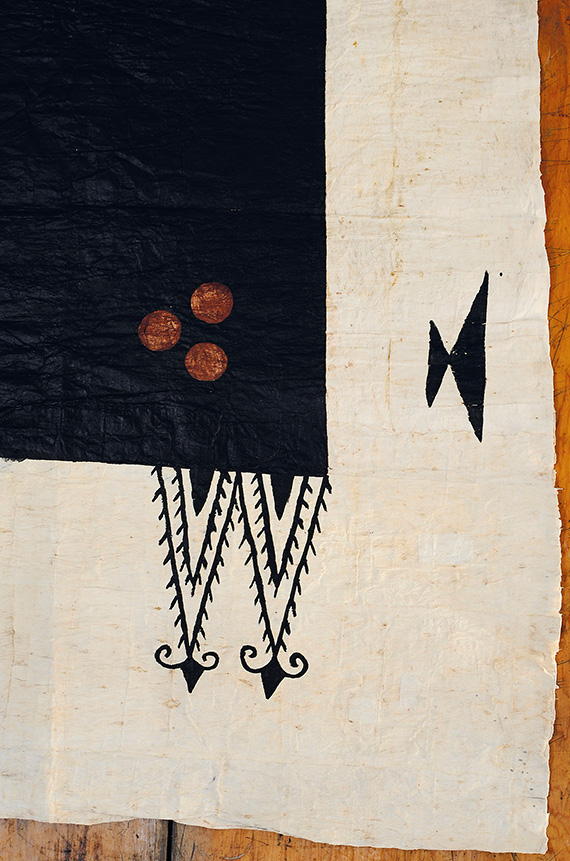
Delicate body adornments from both locales contrast starkly with two major installations taking up the length of Gallery 3.5: the dramatic grouping of 76 Banumbirr (morning star) poles by artists from Galiwin’ku, Arnhem Land; and an epic 22-metre Tongan ngatu tā’uli (black-marked barkcloth). They each have an imposing presence, asserting the importance of aesthetic objects in maintaining cultural and social relationships through their patterns and forms, connecting people across time and space, and reiterate the creative work essential for the continuation of ancestral narratives and practices. These works show each culture’s distinct traditions, as well as the valuable collaborative ethos inherent in both.
Included in this exhibition are works intimately connected with the body. Worn ceremonially and for personal adornment, they have their origins in individual and group expression. Historically, such valuable, portable pieces have played an important role in the trade networks of Oceania and Australia. The riji (pearlshell pendants), for example — made by Aboriginal elder Aubrey Tigan of the Bardi/ Jawu people from the west Kimberley coast — gathered talismanic power as they passed along ancient trade routes, penetrating deep into the deserts of Central Australia, north to Katherine and south to the Great Australian Bight. Tigan’s precious pendants are made from natural, locally sourced materials, to be worn by young men during initiation as pubic covers, suspended from a belt of spun hair string. The designs inscribed into their iridescent surfaces were received in dreams sent from the artist’s spirit guides. The materials and patterns embody the forces of light and water and hold great significance in rain-making rituals; flashing in firelight they evoke the lightning that precedes summer storms.
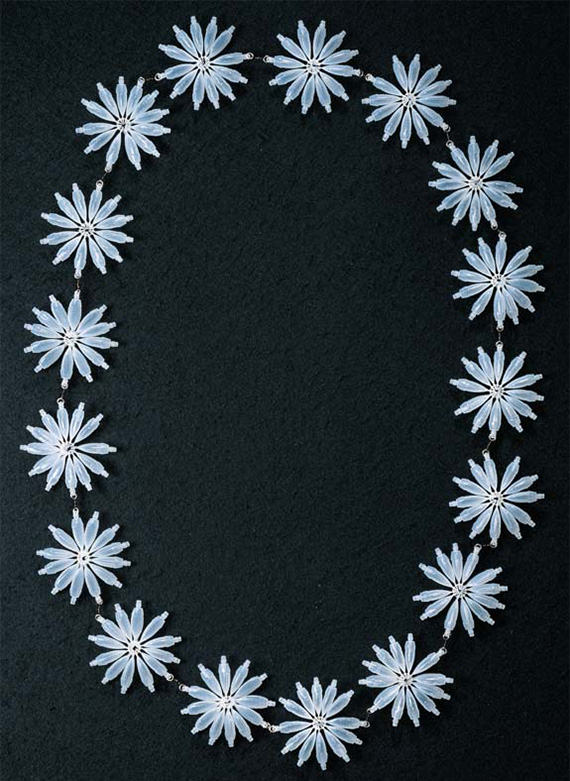
New Zealand artists Sofia Tekela-Smith and Niki Hastings-McFall convey a unique sense of their contemporary Polynesian cultures in a range of neckpieces reflecting their personal memories and histories. Natural materials that locate works in the Pacific region (diridamu seeds, greenstone, mother of pearl and coconut shell) contrast with contemporary materials (including plastic soy sauce containers, sterling silver and black brass fishing swivels), reworked into ultra-modern forms of customary flower leis.
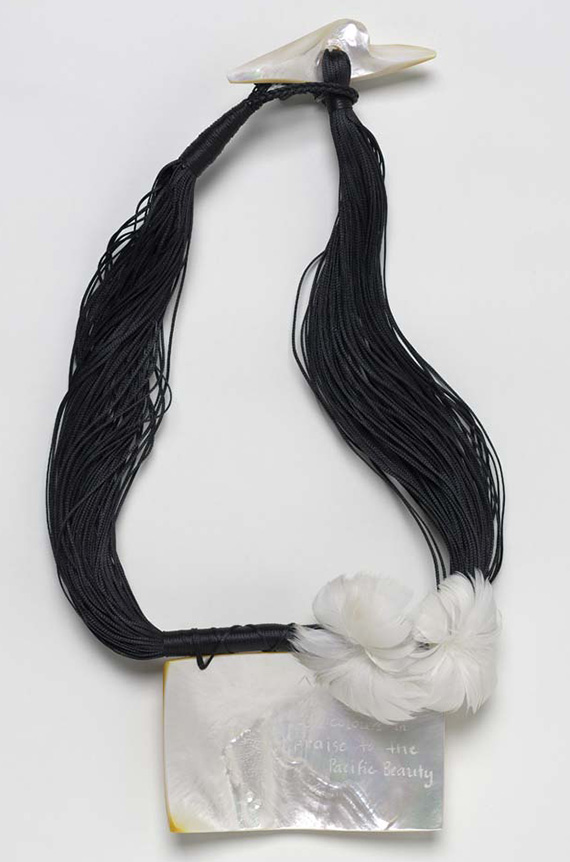
The materials used by Tekela-Smith and Hastings-McFall, intended to recall the softness of feathers and flowers, connect with the string and feather adornments worn in dynamic dances by eastern Arnhem Land clans. Local bird feathers, valued for their symbolism and brilliant colours, are combined in headdresses, dancing belts, armbands and necklaces of luminous beauty, reflecting the deep truths that link the performers to ancestral beings, country and kin.
The Banumbirr (morning star) poles in ‘Lucent’ resemble those used annually in north-eastern Arnhem Land ceremonies that celebrate the morning star and, in a diplomatic gift exchange, are used to develop relationships of mutual respect and obligation between disparate clans. Banumbirr (the planet Venus) is believed to have first risen in the east, lighting the way for the ancestor spirits on their journey to create people and country. Hidden by an old woman during the day in a special woven bag, the star is released on a long, feathered string each evening to travel over the land and herald the dawn. As the sun appears, the woman reels the string back in, secreting Banumbirr in her bag until evening falls.
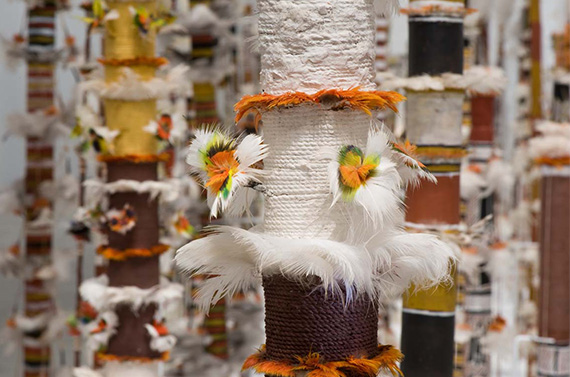
Raki (string), spiritually central to the Banumbirr story, is made collaboratively from bark fibres and human hair wrapped around the poles and then painted with clan designs. Great lengths of feathered strings, pul pul (bunches of exquisitely composed feathers) and feather tufts representing the bright star are attached to achieve the transcendent beauty Banumbirr poles require. Grouped in ‘Lucent’ by individual artist, audiences can discern cultural, aesthetic and technical variations in the poles and the creative exchanges occurring between different clan groups.
A circular pandanus mat from Fijian artist Maraana Vamarosi articulates the continuing exploration of the woven form in this country. The first artist to be supported through the Oceanic Women’s Fund, provided through the generosity of the late Jennifer Phipps, Vamarosi chose to experiment with the softer somo (black) died pandanus fibres and double weave techniques to create this innovative mat for ‘Lucent’.
Ngatu tā’uli 2011 was especially commissioned to mark GOMA’s fifth anniversary in 2011. It is timely that it is displayed again in the Gallery’s tenth year. This sumptuous, 22-metre, black-marked Tongan barkcloth, occupies half the gallery space, competing with the Banumbirr poles for dramatic effect. Draped from the wall and stretching along a low, flat plinth, its dark presence sits in stark contrast with the light evoked by the poles. In fact, Uli (black) relates to the fefine (female) forms of night, moon, darkness and death.
A ngatu tā’uli is a work of art imbued with great spiritual and cultural significance, largely through the collaborative and formal processes of its making. This ngatu was made by Kulupu Falehanga ‘I Teleiloa, a Tongan women’s collective based in New Zealand working directly with women with whom they have family connections from Tatakamotonga, Tonga. Black ngatu, associated with Tongan royalty and aristocracy, are used especially for funerary rites; Ngatu tā’uli added spiritual and cultural value as one of five ngatu that were folded to create a platform for the casket of the father-in-law of one of the group’s members, the late Tēvita Tofavaha Tuai, who was distantly related to the aristocracy of the now uninhabited island of ‘Ata. Its importance required that it be formally presented to the Gallery on completion. Ngatu tā’uli is made from strips of hand-beaten paper mulberry bark and painted with a predominantly black composition. In this contemporary form, a combination of old and new materials and techniques were used. For example, a commercial black pigment was carefully selected to replicate the shiny depth of the natural pigments unavailable in New Zealand. Four main designs (kupesi) feature in a unique combination. They include hea fruits (fakafo’ihea), an abstraction of the male and female reproductive organs; caressing bamboo (amoamokofe), a healing device; a chicken tail (muimoa), a royal delicacy; and a double-hulled canoe (vakatou).
The transformation and use of barkcloth is a primary form of aesthetic and cultural expression in the Pacific. In fact, textiles continue to be integral to practices essential in both Pacific and Aboriginal life. Given centre stage in ‘Lucent’, these seemingly fragile and ephemeral fibre works assert, in a quiet way, the strength, vitality and resilience of Aboriginal and Pacific societies, currently negotiating experiences of migration, cultural displacement and cross-cultural interaction.
This is an extract from the Gallery’s Artlines magazine available from the Gallery Store and online. Keep up to date with the Gallery’s seasonal publication delivered each quarter to QAGOMA Members.
‘Lucent: Contemporary Aboriginal and Pacific textiles’ is at the Gallery of Modern Art (GOMA) from 26 November 2016 to 30 July 2017.
Co-curated by Diane Moon and Ruth McDougall
‘Lucent’ is part of the GOMA turns ten celebrations, so come along and help us celebrate.
